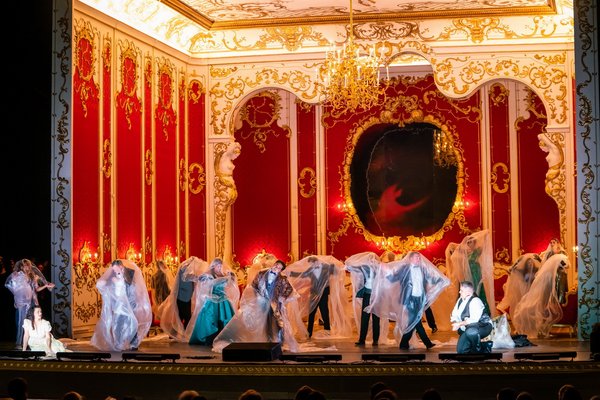
ВОЙНА И МИР (WAR AND PEACE)
2 June 2024, 11 a.m.
In Brief
Opera in thirteen scenes, in two parts, in Russian with Hungarian, English, and Russian subtitles
Prokofiev was inspired to compose a musical drama based on Leo Tolstoy’s colossal historical novel War and Peace by the invasion of Russia by Nazi Germany. The Peace in the first half of the opera is a series of Prokofiev’s most beautiful and intimate tableaus, and it forms a strong contrast with the tsarist (or Soviet) scenes of the second, War part. Prokofiev paints a masterful picture of the fight of the masses and the individual characters in it. He interweaves the plot into a gigantic tale of love and death. The opera featuring 72 characters is adapted and produced by Catalan director Calixto Bieito.
Co-production of the Hungarian State Opera and the Grand Théâtre de Genève
Performing rights licensed by Musikverlag Hans Sikorski GmbH, Berlin.
Details
- Location
- Hungarian State Opera
- Date
- June 2, 2024
- Start time
- 11 a.m.
- End time
- 3 p.m.
Synopsis
PART ONE
Andrei Bolkonsky, disillusioned and mentally and physically damaged, has withdrawn completely into himself; he feels closer to death than to life. But when he hears Natasha and her cousin Sonya singing about spring and the beauty of nature, life awakens in him — and around him.
A little later, Andrei and Natasha come closer to each other in the midst of a boisterous, immature party. What takes place between the guests borders on the surreal.
Natasha and Andrei fall in love with each other.
Everyone makes fun of Andrei’s friend, the perpetually drunk outsider Pierre. Pierre’s brother-in-law Anatole is enthralled by Natasha and hell-bent on seducing her. His sister Hélène promises Anatole that she will support him.
Natasha and her father, Count Rostov, want to introduce themselves to Andrei’s father and his sister Marya, for Natasha and Andrei have meanwhile become engaged. But old Bolkonsky disapproves of his son’s union with Natasha and humiliates her. This is all grist for Anatole’s mill: deeply hurt by the behaviour of Andrei’s family, Natasha gets involved with Anatole. He secretly wants to elope with her and promises to marry her, even though he is already married. But Sonya, Natasha’s cousin, sees through Anatole’s plan. She reveals it to Natasha’s godmother Marya Akhrosimova. In desperation, Natasha tries to take her own life.
Pierre calls Anatole to account and forces him to hand over Natasha’s letters. In the process, Pierre becomes aware of his own feelings for Natasha.
Denisov speaks of an imminent war.
PART TWO
The war has begun.
Amid the fighting, Andrei wistfully remembers his lost love and his fleeting moments of happiness with Natasha. Now that Natasha has betrayed him with Anatole, his life once again seems meaningless. Pierre feels that he will not see Andrei again.
‘Napoleon’ gets carried away with his role as the eternally conquering general and dreams of a victory — but the reality is different.
General Kutuzov can only watch in shock as he realises the game for Moscow is lost. The city is abandoned to destruction.
In the midst of great chaos, Pierre imagines himself as a hero who carries out an assassination to save everyone. His fantasies culminate in hysteria and sarcasm. Like a holy fool, Platon Karataev appears and comforts Pierre.
Badly wounded, Andrei lies dying. He is feverish. He meets Natasha — his great love — for the last time. Would a happy life with her have been possible? Andrei dies, Natasha begins a new life.
Pierre fails to protect his new friend Platon Karataev; Karataev is murdered. The possibility of freedom and a relationship with Natasha appears in Pierre’s mind’s eye. But Natasha is unattainable for him.
Gallery
Reviews
"The neo-Renaissance finery of the Hungarian State Opera House provides the perfect stage for this vision of Russian decadence. (...) The Budapest opera house’s vast stage has been boxed in, jewel-box style, so that when the full cast of singers emerges for the ball – the 28 leads (!) will go on to cover 45 named parts – the event appears crowded and intimate, even stifling. Within these close quarters, everything is intensified, including the story itself. The historical tale of tragic hopes and bittersweet victories has been distilled from more than a thousand pages of prose into a dizzyingly accelerated series of 13 tableaux."
Elodie Olson-Coons, Bachtrack
